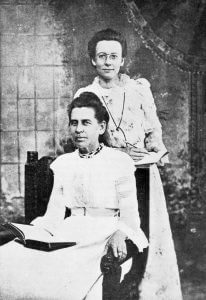Pioneering WFMS & WCTU Missionary to the Philippines

Cornelia Chillson Moots or “Mother Moots” was one of the four pioneer WFMS missionaries to the Philippines. A native of Bay City, Michigan, Moots was an evangelist for the Women’s Christian Temperance Union (WCTU), an organization with recognized links to holiness piety.
Moots took over duties at the Soldier’s Institute in Manila. Despite the tragic loss of her own adopted son Charlie in a Manila hospital, who died from injuries sustained in battle prior to her arrival, Mother Moots found comfort ministering to her new “sons,” a job assigned to her by Bishop Thoburn as the so-called “pacification” of the islands by the United States dragged on.
In addition to engaging in WCTU activities, she visited the sick, wounded, and dying in hospitals in and around Manila. On March 18, 1900, Bishop Warne designated her as class leader of the first Methodist class meetings organized in Manila, consisting of soldier boys who were awakened at the YMCA union meetings where Warne preached. Meeting at the Soldier’s Institute and at the mission home, the class provided opportunities for Moots to kneel with “homesick and sin-sick soldiers” as they “wept and prayed for deliverance from grief, and from the gambling habit, from the drink appetite, and other sins.” In addition to class meetings, she also led separate prayer meetings.
Moots did not work alone, however; she received help, albeit from an unexpected reinforcement. Much of her WCTU evangelistic activities were done in collaboration with Genevieve Cutler, who was affectionately called “Sister Ruth” by the soldiers she minister to. Cutler was a missionary sent by the Peniel Mission, a holiness rescue mission based in Los Angeles.
On September 1900, Sister Ruth, who was superintendent of the evangelistic department of a small band of WCTU women in the city, conducted a series of “gospel meetings” or “gospel temperance meetings” for a few weeks at the Soldier’s Institute, and at “Seamen’s Bethel.” Bethel was a similar hall for sailors in the nearby district of Binondo converted from a recently closed liquor saloon. Moots, who was on hand to distribute temperance pledge cards and pray with those who responded to the message, described the meetings at Bethel as occasions for the “outpouring of the Holy Spirit.”
When Cutler was recalled back to Los Angeles a month later, Moots and Nellie Moody, another newly arrived Peniel missionary, carried on with the meetings at Bethel. In July 1901, the two traveled to San Isidro, Nueva Ecija, a recently occupied town sixty miles north of Manila, to minister to the soldiers of the Twenty-Second Infantry Regiment who were garrisoned there. They conducted a series of evangelistic meetings in a vacant room located in the army hospital and at the surgeon’s home. The success of the meetings was demonstrated when the soldiers paid for the construction of a bamboo “Gospel Peniel Hall” built by Filipino prisoners. Moots dedicated the building on October 20, 1901, and preached the inaugural sermon.
In the absence of any MEC work in San Isidro, Moots also launched a separate work with some of the locals. They would later form the pioneering membership of the MEC in the province a year later.
Adapted, with the author’s permission, from Luther Jeremiah Oconer, Spirit-Filled Protestantism: Holiness-Pentecostal Revivals and the Making of Filipino Methodist Identity (Eugene, OR: Pickwick Publications, 2017), 40-6.




